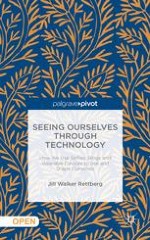Open Access 2014 | Open Access | Buch

Seeing Ourselves Through Technology: How We Use Selfies, Blogs and Wearable Devices to See and Shape Ourselves
verfasst von: Jill Walker Rettberg
Verlag: Palgrave Macmillan UK
Open Access 2014 | Open Access | Buch

verfasst von: Jill Walker Rettberg
Verlag: Palgrave Macmillan UK
This book is open access under a CC BY license. Selfies, blogs and lifelogging devices help us understand ourselves, building on long histories of written, visual and quantitative modes of self-representations. This book uses examples to explore the balance between using technology to see ourselves and allowing our machines to tell us who we are.